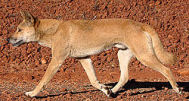 Media Release... Exactly as I or anyone would have thought. A hungry dog is more likely to approach people and try and get food, and then they have to be "managed" to prevent attacks. It's all a self-fulfilling prophesy to keep their numbers down for tourism. The fine was more about upsetting the status quo and about having their little scheme exposed for what it is. People living on islands don't usually survive without importing food. Why should these animals have to? "Sustainable" numbers for dingoes is one thing, but "sustainable" human numbers - and their overshoot - gets ignored.
Media Release... Exactly as I or anyone would have thought. A hungry dog is more likely to approach people and try and get food, and then they have to be "managed" to prevent attacks. It's all a self-fulfilling prophesy to keep their numbers down for tourism. The fine was more about upsetting the status quo and about having their little scheme exposed for what it is. People living on islands don't usually survive without importing food. Why should these animals have to? "Sustainable" numbers for dingoes is one thing, but "sustainable" human numbers - and their overshoot - gets ignored.
Save Fraser Island Dingoes Inc.
13 Sept. 2011
Dingo Strategy has no bite...
Recent reports obtained through freedom of information suggest that the government has been misleading the public regarding the cause of aggression by the Fraser Island Dingo.
These reports, dating back to 1994 and Commissioned by the Government, clearly demonstrate that feeding is not the main cause of aggressive behaviour. In fact the reports state that loss of fear when combined with hunger, is the actual cause of problem behaviour (Price 1994) and the incidence of stalking is most likely attributed to lack of foods available.
This study confirms what scientists and researchers have been saying for years, lack of food is a major factor in causing unnatural and inappropriate behaviour. A hungry animal can become volatile and unpredictable. Constant trapping, ear-tagging, hazing and destroying of animals disrupts the pack structure which, in turn, leads to anti-social behaviour, but this is not recognised in the Dept. Of Environment and Resource Management's Dingo Strategy.
DERM was aware that limiting food sources, such as closing the dumps, would have consequences. The dump closure...is blamed for starvation (Price 1994), but did not consider it of importance.
The study also discusses the fact that nipping and biting is usually provoked by visitors and that a juvenile dingo's natural curiosity and play-behaviour can be misinterpreted as aggression. Price states, nuisance behaviour is usually associated with a juvenile animals playful character". But again DERM has ignored its own findings and the majority of animals destroyed today are juveniles.
Jennifer Parkhurst, Wildlife Photographer, was fined a sum of $40,000 including a 3 year suspended sentence for feeding starving animals and allegedly causing them to become dangerous. At the time this was considered excessive, as the maximum fine for feeding a dingo is $4000; now it seems ridiculous.
DERM's management strategy is apparently based on the observations of rangers and students during the course of their field work. Jennifer Parkhurst spent 7 years of observations but her findings were dismissed.
In light of this study questions need to be asked:
Why did DERM spend so much time and effort pursuing Ms. Parkhurst in an attempt to denounce her research when her findings were similar to those of their own department?
Why did DERM subsequently use a photograph from Ms. Parkhurst's study on its website if her findings were discredited?
Why does DERM continue to deny that its management was not responsible for starvation of the dingoes when clearly this document shows that the strategy had a huge impact on the dingoes behaviour?
Why is the public only fined for feeding, but allowed to torment and tease the dingoes?
Why is the signage on the Island only warning tourists not to feed dingoes, but no signage warning tourists not to abuse the animals?
Why are members of the public not held accountable for their actions, such as not supervising children?
Why are juvenile dingoes still being targeted for destruction when exhibiting natural behaviours?
Save Fraser Island Dingoes Inc. will be taking these questions, and many more, to the government...
Sincerely,
Save Fraser Island Dingoes Inc. Committee
President Malcom Kilpatrick
50 Old Maryborough Rd.
Pialba Qld. 4655
Ph: 07 4124 1979 Email: [email protected]

Comments
quark
Sat, 2011-09-17 12:16
Permalink
Dingoes need to eat
Add comment